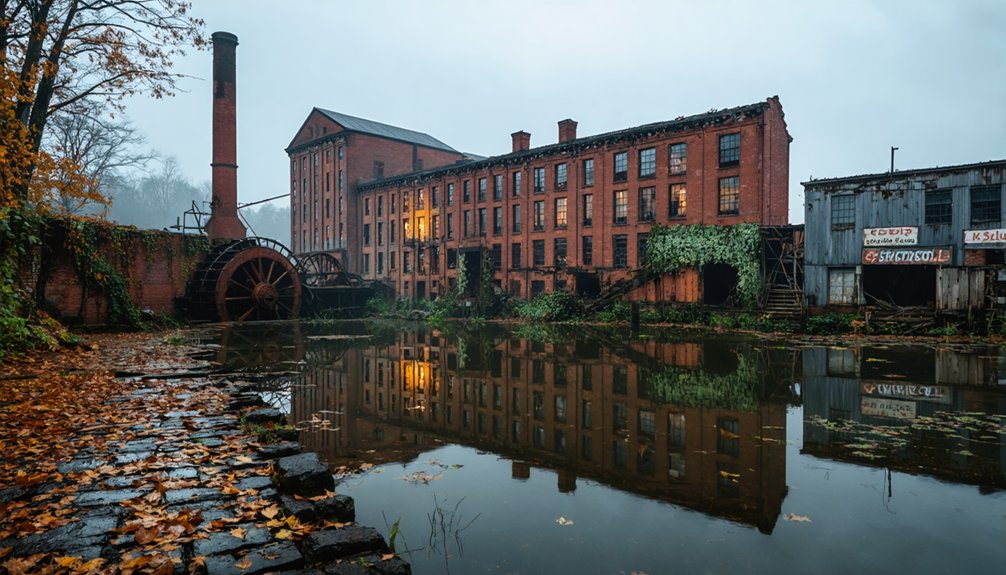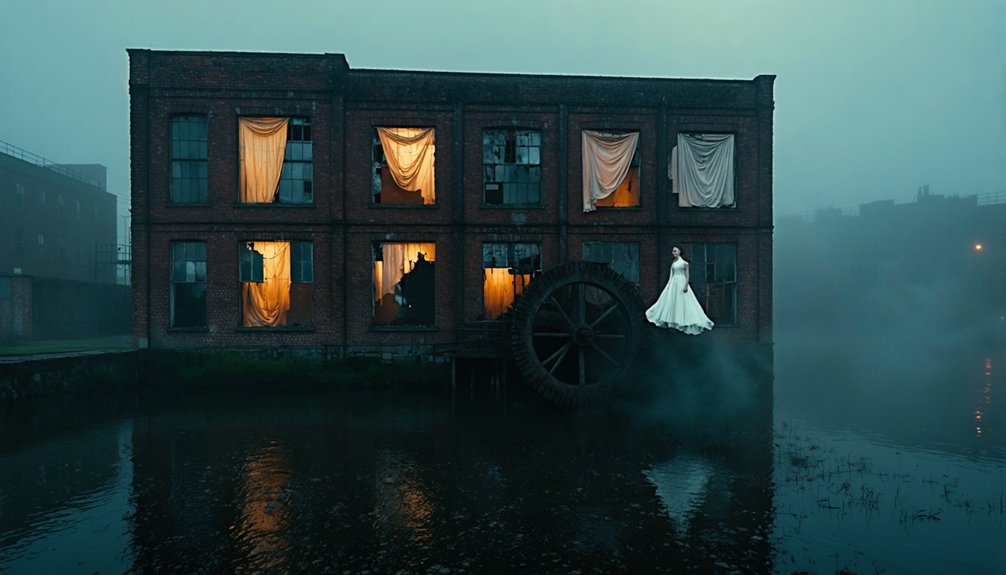When you visit abandoned Southern mill towns, you’ll encounter the haunting presence of former residents who once lived under strict company control. In places like Henry River Mill Village, now silent buildings housed workers who received “doogaloo” wages and endured 12-hour shifts from the early 1900s until abandonment in 1987. Natural disasters and economic collapse transformed thriving communities into ghost towns, where paranormal investigators now document unexplained phenomena. These weathered structures hold stories waiting to be discovered.
Key Takeaways
- Abandoned textile mills frequently report paranormal activity linked to industrial-era tragedies and harsh working conditions.
- Investigators document EVPs, cold spots, whispers, and shadow figures believed to be former mill workers.
- Remaining mill town structures serve as conduits for ghostly encounters, preserving traumatic memories of disasters and difficult lives.
- Former residents who stayed behind often become storytellers, sharing tales of those who once populated these industrial communities.
- Historical preservation efforts capture not just physical remnants but also the spiritual presence and lingering energy of past mill communities.
The Rise and Fall of Southern Mill Towns
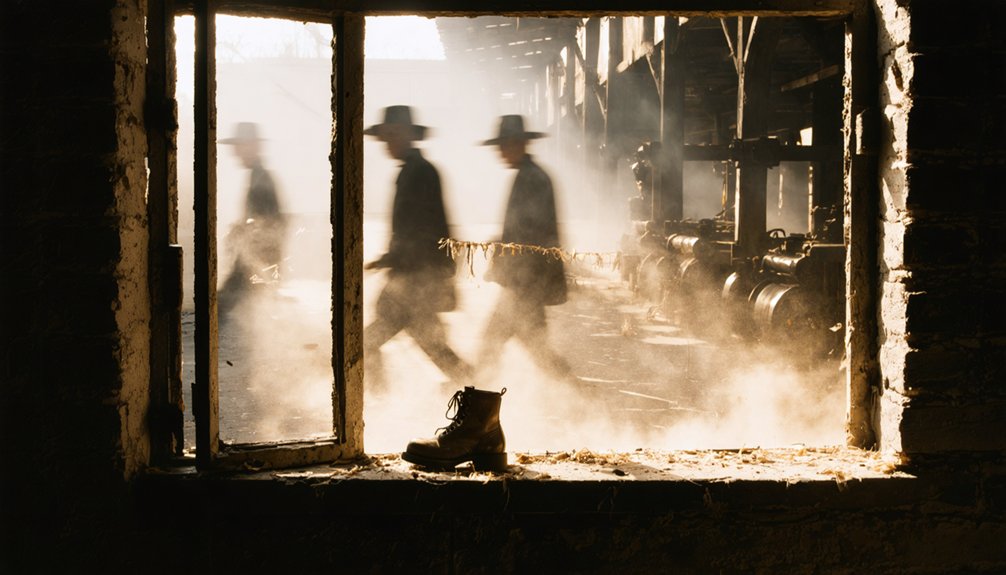
Following the tumultuous years of the Civil War, the South’s economic landscape transformed radically as industrial development surged to fill the vacuum left by slavery’s abolition.
You’d have witnessed northern capitalists and local merchants backing mill construction along Piedmont waterways, their railroads pushing deeper into rural communities with each passing year.
White yeoman farmers, desperate to escape the oppressive crop lien system, increasingly abandoned their agricultural roots to seek employment in these emerging mill towns.
The late 19th century saw widespread community participation in southern industrial growth, as evidenced by the Cotton Mill Campaign that encouraged local entrepreneurs to establish new manufacturing facilities in 1880.
Paying With “Doogaloo”: Life Under Company Control
As you walked through the gates of a Southern mill village in the late 1800s, you’d immediately encounter a peculiar economic system designed to ensnare workers in a web of dependence.
Your weekly wages—a meager $2.50 to $10.50—wouldn’t come as cash but as “doogaloos” or “loonies,” tokens only redeemable at company-owned establishments.
This doogaloo economy created perfect token dependence. You’d shop at the company store where prices were deliberately inflated. When your tokens ran short, you’d take advances, sinking deeper into debt.
“I owe my soul to the company store” wasn’t just a saying—it was your reality.
Mill owners controlled everything: your housing, food, education, and even spiritual life. By 1900, 92% of textile workers lived in these company-owned villages, completely surrounded by the mill’s influence.
Typical workers endured 10 to 12 hour shifts six days a week, leaving little time for life outside the mill’s shadow.
This system effectively prevented unionization, outside employment, or savings—keeping you and your family bound to the mill for generations.
Disaster and Abandonment: When Communities Vanished
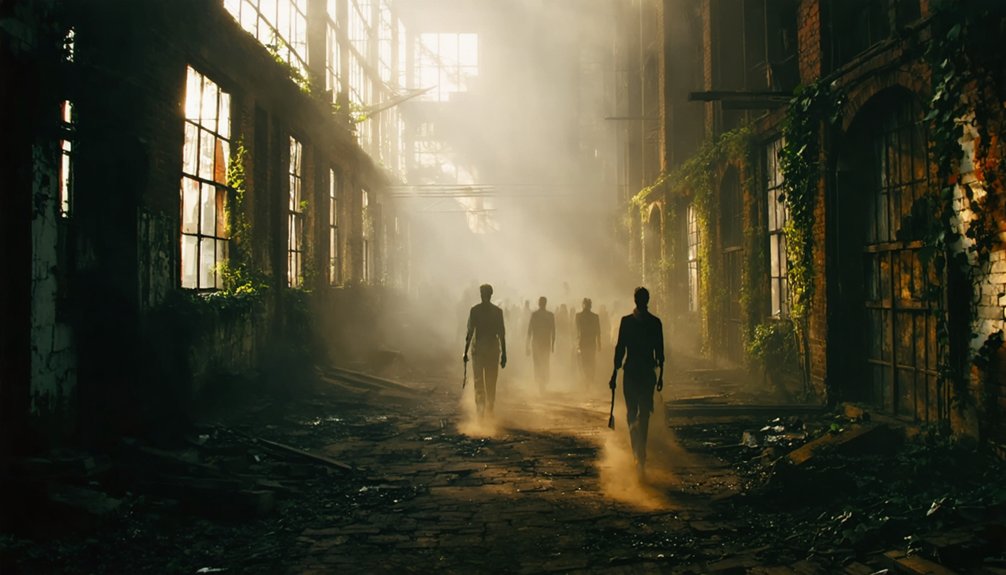
You’ll find that Henry River Mill Village’s story took a dark turn with devastating fires and floods ravaging its structures between 1973 and 1987, events that forced the remaining inhabitants to flee their cherished homes after generations of community life.
What had once been a thriving industrial town with over 20 buildings and a population dependent on mill operations became completely abandoned by 1987, when the last resident departed after witnessing decades of decline that transformed vibrant neighborhoods into ghostly remnants.
Despite these calamities, the physical infrastructure remains frozen in time—a strikingly modern ghost town from the industrial age—bearing silent testimony to the resilience of those who once called this place home. The village gained renewed attention when it was featured as District 12 in The Hunger Games film, bringing curious tourists to explore its abandoned buildings.
This story echoes the broader pattern of rural population decline that affected many American villages after 1860, with similar communities losing residents to growing urban centers and factory towns.
Flood, Fire, Trauma
When devastating natural disasters strike isolated communities with limited emergency response capabilities, the consequences often prove fatal for the settlement’s very existence.
You’ve seen this pattern throughout history—remote towns like Dhanushkodi, India, completely wiped out by the 1964 cyclone, with no chance for recovery.
In mill towns, you’d find vulnerability built into their very foundation. Dependent on seasonal water sources, they lacked flood resilience when waters inevitably rose beyond control.
Geographic isolation compounded these disasters, leaving communities without adequate fire recovery resources when catastrophe struck. The disproportionate impact of these events created trauma that lingered in community memory.
Many of these sites, like Fayville, Vermont, now exist as deserted mill towns that stand as testament to the fragility of industrial settlements.
When extreme weather combined with economic dependency, you’d witness a compounded crisis that accelerated population exodus, turning once-thriving communities into memories. This was certainly the case with Mono Mills, where operations permanently ceased in 1917, and all equipment was sold for scrap in 1918.
Survival Against Odds
Despite devastating natural disasters and economic collapse, certain mill towns and isolated communities managed to survive through remarkable adaptability and resilience.
You’ll find these surviving towns typically developed diverse economic bases rather than relying on a single industry. While neighboring settlements withered, these communities demonstrated exceptional community resilience by establishing retail centers, service hubs, and community institutions that attracted residents from surrounding areas.
They’re clustered settlements rather than dispersed farmsteads, creating stronger social networks that weathered difficult shifts.
When you examine their economic adaptation patterns, you’ll notice strategic pivots—former mining towns becoming tourist destinations, mill villages transforming into heritage sites. Their proximity to transportation networks or regional markets proved essential, allowing them to reinvent themselves while preserving their unique historical identities and maintaining population bases despite the broader rural exodus.
The Last Residents: Stories of Those Who Stayed Behind
While thousands fled the economic collapse of America’s once-thriving industrial centers, a resilient few chose to remain, becoming the final guardians of communities that time seemed determined to forget.
You’ll find them in McKeesport and Flint, where their weathered faces tell stories of personal sacrifice. They’ve watched neighbors pack U-Hauls since the 1950s, yet refused to abandon their roots. Similar to the last residents of abandoned communities like Pyramiden, where the final permanent resident departed on October 10, 1998, leaving behind a once-vibrant Soviet settlement.
Some couldn’t afford to leave – trapped by upside-down mortgages and limited job prospects elsewhere. Others stayed because of deep community resilience, anchored by family connections spanning generations. In neighborhoods like ZIP 44507 in Youngstown, where home values average $20,000, residents face stark economic realities that shape their daily lives.
Financial constraints held some captive while familial bonds anchored others to towns forgotten by prosperity.
Their personal narratives reveal consistent themes: the comfort of churches that still hold services, the familiarity of streets where everyone knows your name, and the surprising affordability that allows survival on fixed incomes while younger residents seek opportunity elsewhere.
Hollywood’s Spotlight on Forgotten Places
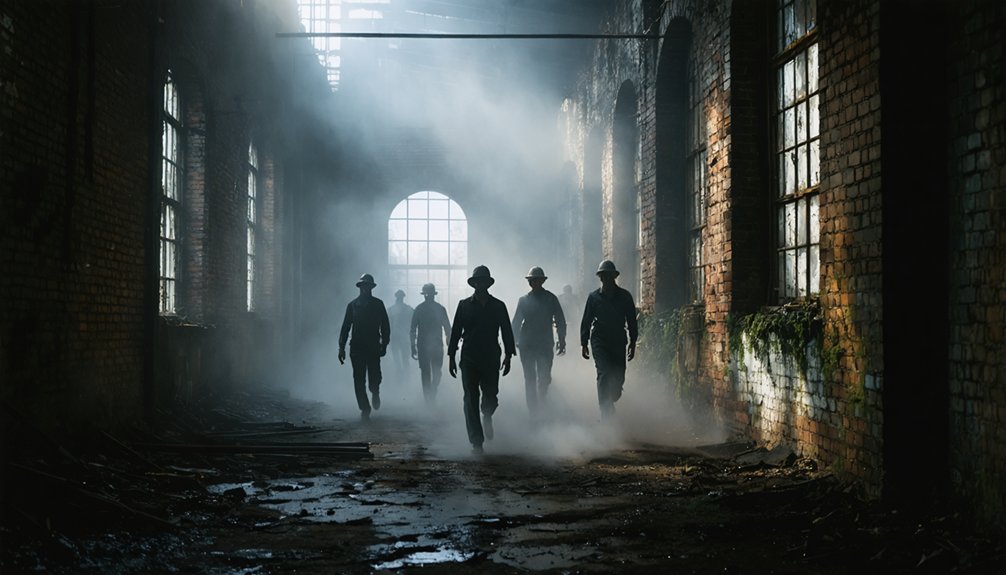
You’ll notice how Hollywood’s fascination with Henry River Mill Village transformed this forgotten town into “District 12,” bringing thousands of fans to North Carolina after “The Hunger Games” release in 2012.
Your abandoned communities, once invisible to the outside world, suddenly find themselves thrust into international spotlight when film crews arrive to capture their haunting authenticity and architectural character.
These cinematic appearances often create a ripple effect of tourism and preservation interest, as demonstrated at Rhyolite, Nevada, where Paramount Pictures’ partial restoration for filming has helped maintain the ghost town’s structures for future generations.
District 12 Effect
The phenomenon known as the “District 12 Effect” emerged dramatically in 2012 when the first installment of The Hunger Games transformed Henry River Mill Village from a crumbling North Carolina ghost town into an overnight tourist destination.
You’ve likely witnessed this pattern before—Hollywood discovers an abandoned location that perfectly captures cinematic authenticity, and suddenly a forgotten community finds itself thrust into the national spotlight.
When The Hunger Games producers selected Henry River Mill Village to represent District 12, they weren’t just choosing a filming location; they were reviving a community’s narrative.
The decaying mill buildings and empty company homes that once represented economic failure suddenly became valuable cultural assets. Local residents watched as their forgotten history was reframed through fiction, creating an entirely new chapter in their town’s legacy.
Spotlight Breeds Interest
When Hollywood’s cameras turn toward a forgotten ghost town, an extraordinary transformation begins that extends far beyond the screen.
You’ll witness places like Henry River Mill Village evolve from a decrepit shell into District 12’s cultural significance, drawing fans who never knew of its existence before The Hunger Games.
This spotlight creates economic revival where none existed.
Hashima Island transformed from an abandoned coal mining community into a UNESCO site after its Skyfall appearance.
Six Flags New Orleans found new purpose through productions like Jurassic World, while Spain’s Tabernas Desert maintains the iconic set from The Good, The Bad and The Ugly as Oasys MiniHollywood.
You’re experiencing a phenomenon where Hollywood’s gaze doesn’t just capture these places—it resurrects them, breathing life back into communities once forgotten by time.
Ghostly Encounters: Paranormal Claims in Abandoned Mills
Why do abandoned textile mills across America continue to attract paranormal investigators decades after their machines fell silent?
These haunting grounds tell stories of industrial-era tragedies, particularly of child workers who perished in machinery accidents.
Echoes of America’s industrial past linger where young souls were sacrificed to the relentless hunger of uncaring machines.
You’ll find paranormal investigations concentrated at notorious locations like Slater Mill in Rhode Island, where staff report children’s screams echoing through empty rooms, and Maryland’s Savage Mill, where former workers’ spirits allegedly linger.
When you visit these sites, expect common phenomena: sudden cold spots near machinery, unexplained whispers, shadow figures darting through peripheral vision, and electronics malfunctioning without explanation.
The connection between these mills’ brutal working conditions—where children as young as four labored around dangerous equipment—and today’s paranormal activity creates a compelling historical narrative that keeps ghost hunters returning to document EVPs and unexplained sensory experiences.
Preserving the Memories: Documentation Before Decay

While paranormal enthusiasts search for ghostly traces of the past, preservationists race against time to document the physical remnants before they vanish forever.
You’ll find dedicated archaeologists measuring foundation layouts, cataloging massive steel stamps, and mapping complex timber frames that once powered industry.
The historical significance of these structures extends beyond the main buildings. Documentation teams meticulously record mill races, sluices, miller’s houses, and blacksmith shops—creating extensive archives that capture each site’s complete story.
Before rot claims timber supports or floodwaters undermine foundations, mill documentation becomes urgent cultural work.
Through collaborative efforts between public agencies and private owners, these industrial landmarks find new life. The careful balance between preservation and adaptive reuse guarantees that when you visit these spaces, you’re experiencing authentic connections to craftsmanship and community heritage.
Frequently Asked Questions
Were Any Mill Towns Successfully Revitalized After Initial Abandonment?
Yes, you’ll find numerous mill towns revitalized through strategic public-private partnerships, adaptive reuse, and revitalization strategies that prioritized community engagement, transforming abandoned industrial sites into vibrant mixed-use destinations.
What Happened to the “Doogaloo” Coins After the Mills Closed?
After mountains of doogaloo coins became worthless, you’d find them transformed into collectors’ items, museum artifacts, and family heirlooms—preserving mill town history while freeing them from their original economic chains.
How Did Nearby Towns Absorb Displaced Mill Workers?
You’ll find nearby towns couldn’t fully absorb displaced workers. Limited job capacity, high unemployment rates, and challenging community integration created lasting economic impact, forcing many to retire early or commute long distances.
Did Any Residents Return to Document Their Former Lives?
Like moths to a flame, you’ll find many former residents returned to document their lives through memory preservation projects, recording personal narratives in oral histories that meticulously chronicle their mill town experiences.
Are There Efforts to Reconnect Former Residents With Their Heritage?
You’ll find extensive heritage preservation efforts reconnecting former residents through oral history projects, community engagement events, and school partnerships where students collect elders’ stories—all celebrating your freedom to reclaim your mill town roots.
References
- https://www.orphanednation.com/the-ghost-town-of-henry-river-mill-village/
- https://www.islands.com/1988321/mortimer-north-carolina-abandoned-ghost-town-historic-pisgah-national-forest/
- https://www.youtube.com/watch?v=kdE5O-cI1Bo
- https://www.youtube.com/watch?v=5wytKBsjSYw
- https://theforgottensouth.com/coleridge-north-carolina-ghost-town/
- https://en.wikipedia.org/wiki/Ghost_town
- https://roadtrippers.com/magazine/henry-mill-river-hunger-games-district-12/
- https://www.gastongazette.com/story/business/2015/10/30/gaston-s-own-ghost-town/33185415007/
- https://thoughtandsight.com/henry-river-mill-village-a-ghost-town-turned-site-of-hunger-games-district-12/
- https://www.wm.edu/sites/wmcar/research/danvilledig/history/southern-mill-industry/

